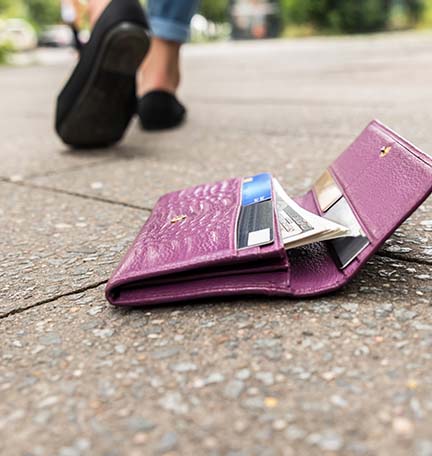Online shopping scams are becoming increasingly common. Learn how to protect yourself before making your next purchase.
If you’re like many Americans, you’ve made dozens of online purchases this year — and if you’re like some, you do your shopping almost exclusively online. While you may think you’d be able to spot the signs of an online shopping scam, scams are becoming increasingly sophisticated, causing even the most well-informed buyers to fall victim.
While fraudsters are constantly evolving their schemes in order to avoid being caught, most online shopping scams involve similar themes. By familiarizing yourself with these common types of online shopping scams, you’ll be able to spot red flags before falling victim to fraud.
Fly-by-Night Sites
As you’re scrolling through your favorite social media platform, you stumble upon an advertisement for something you’d love to purchase. You click on the ad and are taken to a website that you’ve never heard of before. While the name is unfamiliar, the site looks professional, well-stocked, and appears to be legitimate — so you decide to make the purchase. Unfortunately, you fail to receive the item you’ve purchased, and when you attempt to contact the site, either you’re unable to reach anyone or you find that the website is gone.
How it works: These days, it’s easier than ever to set up a professional-looking ecommerce site. While this is great for legitimate online sellers, it’s also good news for scammers. Often, fraudulent sites will appear well-stocked and professional and will often advertise their wares on platforms such as Instagram or Twitter. In spite of the professional look of the site, in reality it has no merchandise in stock and orders are never filled.
Online Marketplace Scams
You’ve just made a purchase through an online marketplace or auction site you know and trust. The seller notifies you that they’re unable to accept payment through the site, and their reason seems valid. Instead, they’d like you to wire the funds, or send money through another platform such as Venmo or Zelle. Because you wrongly assume that the site’s buyer protections will cover you, you send the money via the requested method and never receive the merchandise or hear from the seller again.
How it works: Unfortunately, buyer protections can be limited, even on well-established online auction sites and online marketplaces. In most cases, payments made outside of the platform aren’t protected for the simple fact that payments made via wire or peer-to-peer money transfer sites can’t be tracked or guaranteed. Scammers know this, and actively use this to their advantage. While the site may ultimately ban the seller, you may have a difficult time recovering your money.
Phony Tracking Numbers
You’ve just made a routine purchase through a website you trust — the world’s largest ecommerce retailer or a well-known auction site, for example. Shortly after paying through a secure method, you receive a tracking number. So far, so good! However, many days pass, and you never receive your package. You check the tracking number, and it shows that your package has been delivered. Upon closer inspection, you notice something is amiss: the tracking shows that the package was delivered to a random location, or the delivery took place days, weeks, or even months before you made your purchase. You reach out to the seller, but they never respond.
How it works: The vast majority of online shopping and platforms rely upon tracking numbers to verify that an item has indeed been delivered as promised. Fraudulent sellers use this to their advantage by repurposing real tracking numbers, making it appear as though they shipped your package and it was successfully delivered, when in fact they took your payment but sent you nothing. In cases like these, it can be quite difficult to prove you didn’t receive the item as promised.
“Free” Product Promotions
You stumble upon an Instagram account featuring a photo of a product you’d love to own. Best of all? It’s free — you only have to pay for shipping. You share your credit card information and wait for your item to arrive. If you’re lucky, it will arrive, but it might not be what you expected — or it might not be worth the amount you paid for shipping. In other cases, you might never receive the item, period.
How it works: The “free” product angle deters people from filing complaints when the product they receive isn’t what they expected, or when it simply doesn’t arrive. As the saying goes, nothing in life is free — and in reality, you’re likely paying a hefty sum for shipping. Ultimately, it’s a good idea to avoid any promotions like these from sellers you’re unfamiliar with, particularly those advertised on social media platforms.
Designer Imposters and Unwanted Substitutions
You see an ad online for a huge sale. Best of all? It’s your favorite designer — one who you never thought you could afford. Everything on what appears to be the designer’s website is marked at a massive discount, and you can’t resist buying at least one item. When the item arrives, if it does at all, it’s clearly a knockoff version of the brand you thought you were purchasing. A similar scam targets individuals purchasing expensive items such as electronics: A package will be shipped and successfully delivered to you, but instead of the iPhone 11 you were expecting, you might receive an iPhone 4, for example.
How it works: Some scammers will purchase domain names that are similar to an official brand’s in order to establish a sense of legitimacy. In some cases, the items you receive will be knockoffs or unwanted substitutions — if you receive anything at all. By the time you realize you’ve been scammed, the site will be gone, and you’ll have a difficult time recovering your money.
How to Protect Yourself When Shopping Online
Online shopping scams are becoming increasingly common, accounting for nearly one in four scam complaints received by the Better Business Bureau in 2020. Here’s how to protect yourself:
1. Do your research
Whenever possible, stick to trusted, well-established websites. When making a purchase through an online marketplace, carefully review feedback, taking note of how many transactions the seller has made and how long they’ve been active as a seller. If you’re unfamiliar with a website, search the site’s name before making a purchase, and check for Better Business Bureau (BBB) complaints. Also, ensure there’s legitimate contact information available, such as a phone number, email address, and physical address.
2. Choose your payment method carefully
When making payments through an ecommerce site, pay via a credit card if you have one. If you have problems with a credit card purchase, you may have to dispute the charge, but the payment will not have been already deducted from your account, as it is when you pay with a debit card or by giving your checking account number. If you’re shopping through an auction site like eBay or an online marketplace such as ThredUp, Etsy, or Poshmark, stick to making payments through the website’s platform. Never wire money directly to a seller, and avoid sending funds for mail ordered transactions via peer-to-peer money transfer apps like Venmo or Cash App.
3. Educate yourself on buyer protections
While the majority of well-established sites offer some degree of buyer protection, there may be certain guidelines you need to follow (such as making your payment through the website’s platform). By educating yourself on a site’s protections, you can better identify potential scams.
Finally, if you do happen to fall victim to a scam, be sure to take action. Always report the incident to the FTC and the BBB. You also may dispute the transaction through the payment platform you used to make your payment, such as your card issuer or, if you made payment directly from your deposit account, your bank. If the purchase was made through a marketplace website, be sure to open a formal complaint via that website.
To learn more about common scams and tips for protecting yourself against fraud, visit regions.com/fraudprevention.










